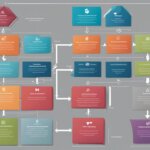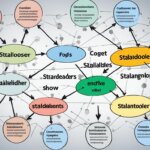Table of Contents
An RFP (Request For Proposal) is a critical step in the procurement process for companies, governments, and organizations. It allows buyers to compare features, functionality, and price across potential vendors. The RFP process involves formalized purchasing, allowing stakeholders to participate in question selection and response scoring. It helps buyers focus on specific criteria important to them and improves outcomes. The RFP process is often managed through email threads with attached documents, which can be challenging to manage and may raise questions about the integrity of the sourcing process. However, when used properly, an RFP can offer both tactical and strategic value, leading to improved ROI and better purchasing decisions.
The RFP Process and Steps
The RFP process is a crucial part of procurement best practices. To effectively navigate this process, it is important to understand the key steps involved. This section will take you through the various stages of the RFP process, providing you with a clear roadmap for success.
1. Discovery
In the discovery phase, the first step is to identify key stakeholders who will be involved in the decision-making process. This can include department heads, executives, and other relevant personnel. During this phase, it is also essential to establish clear business goals and objectives, as well as determine a budget for the procurement project.
Additionally, questions should be drafted to guide the RFP process and ensure that all necessary information is gathered from potential vendors.
2. Draft & Issue
Once the discovery phase is complete, the next step is to draft and issue the RFP. During this phase, specific and targeted RFP questions should be compiled to provide vendors with a clear understanding of the requirements and expectations. It is important to set clear timelines for vendors to respond and to address any questions or concerns they may have.
3. Score & Shortlist
The score and shortlist phase is where stakeholders and sourcing experts evaluate and score the responses received from vendors. This involves assessing each proposal against set criteria and eliminating vendors that do not meet the requirements. The goal is to shortlist the vendors with the highest scores, who will move on to the next phase of the process.
4. Select Winner & Contract
The final phase of the RFP process involves selecting a winner and finalizing the contract. At this stage, additional meetings or demos may be conducted to help make the final decision. Negotiations with the chosen vendor will take place to ensure that the terms and conditions meet the organization’s needs. Once an agreement is reached, a contract will be signed, finalizing the procurement process.
By following these steps, organizations can streamline the RFP process and ensure that the best-suited vendor is selected. Implementing RFP best practices not only leads to improved procurement outcomes but also maximizes value and minimizes risks for the organization.
Stay tuned for the next section where we will address commonly asked questions related to RFPs and provide insights into the differences between RFI, RFP, and RFQ.
RFP FAQs
When it comes to the procurement process, several types of requests are commonly used, including RFI (Request For Information), RFP (Request For Proposal), and RFQ (Request For Quotation). Each request serves a specific purpose and is suitable for different scenarios.
An RFI is typically the first step in assessing whether or not to move forward with an initiative. It allows organizations to gather information and insights from potential vendors, helping them make informed decisions before proceeding to the next stage. An RFI often precedes an RFP.
On the other hand, an RFP is the primary request used in the complex procurement process. It allows organizations to request detailed proposals from potential vendors, outlining the specific requirements, scope, and criteria. The RFP process enables organizations to identify the most suitable vendor based on their capabilities and offerings.
An RFQ, on the other hand, is a solicitation used when organizations require a specific product or service. It focuses on obtaining price quotes for a particular, well-defined requirement.
An RFP is widely considered the best-practice process for big-ticket purchasing, especially for strategic projects or purchases with a significant organizational impact. Its comprehensive nature ensures that organizations can carefully evaluate vendors, compare proposals, and make informed decisions.
When deciding whether to issue an RFP, organizations should consider factors such as project value, complexity, and impact. Implementing an RFP process ensures that purchasing decisions are based on thorough evaluation and alignment with the organization’s goals.

In summary, RFI, RFP, and RFQ are all valuable components of the procurement process. While an RFI helps assess viability, an RFP enables organizations to request detailed proposals, and an RFQ focuses on obtaining specific quotations. Understanding the differences and knowing when to use each request is essential for successful procurement outcomes.
RFP Basics and the RFP Process
An RFP, or Request For Proposal, is a formal document issued to prospective vendors to gather information and proposals for a specific product or service. It plays a crucial role in helping organizations select the right vendor while minimizing cost and risk. The RFP process consists of three core steps: creation, administration, and evaluation.
In the creation phase, stakeholders are identified, project needs and goals are defined, questions are drafted, and the RFP is developed. This involves thorough research and clear articulation of the requirements to ensure that potential vendors have a comprehensive understanding of what is expected. Effective creation of an RFP sets the foundation for a successful procurement process.
The administration phase focuses on distributing the RFP to potential vendors, clarifying any questions they may have, and providing clear timelines for submission. This ensures a transparent and efficient process where vendors have equal access to information and can submit their proposals within the specified timeframe. Effective administration of the RFP allows for a smooth and organized workflow.
During the evaluation phase, stakeholders diligently evaluate and score vendor responses based on predetermined criteria. This helps in objectively assessing each proposal and shortlisting the vendors that best meet the organization’s requirements. The final step involves selecting a winner and negotiating a contract, leading to the successful conclusion of the RFP process.
FAQ
What is an RFP?
An RFP (Request For Proposal) is a formal document issued to prospective vendors to gather information and proposals for a specific product or service.
Why is the RFP process important in procurement?
The RFP process allows buyers to compare features, functionality, and price across potential vendors, helping them make better purchasing decisions.
What are the steps in the RFP process?
The RFP process consists of several key steps: discovery, draft & issue, score & shortlist, and select winner & contract.
What is the difference between RFI, RFP, and RFQ?
An RFI (Request For Information) is used to assess whether or not to move forward with an initiative, an RFP is the first step in the procurement process, and an RFQ is a solicitation for a very specific product or service.
When should I use an RFP?
An RFP is widely considered the best-practice process for big-ticket purchasing, particularly for strategic projects or purchases with a large organizational impact.
How does the RFP process ensure fair vendor selection?
The RFP process ensures that vendor selection is data-based, strategic, and fair, reducing risk and maximizing value for the organization.







